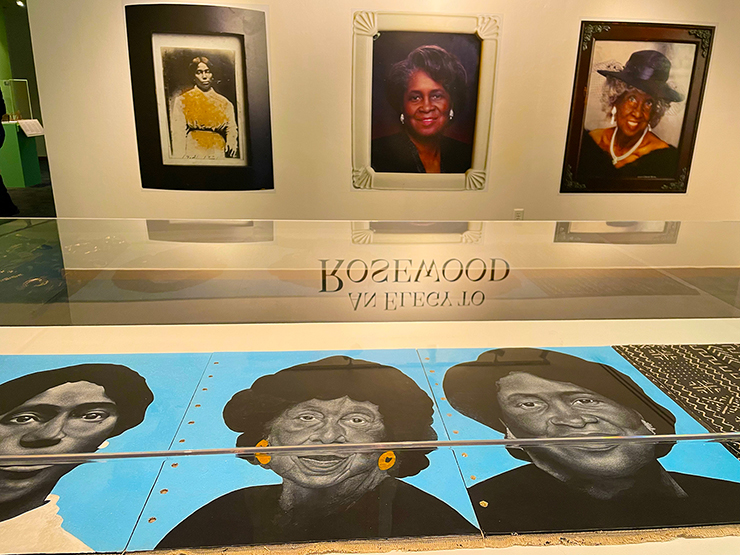
"We Remember, We Remain" portraits by artist Cheri Regans: grandmother Lizzie Brown (1871-1938), and mother Theresa Brown Robinson (1902-1997) of Lizzie Robinson Jenkins. (Photo by Irene Sperber)
Off Florida Highway 24 an historical marker stands, the lonely reminder of a violent part of Florida’s past. From Jan. 1 through 7, 1923, on a section of highway in Levy County, Lizzie Robinson Jenkins's ancestors lived a story to pass down through the generations, first by oral history before Jenkins took on the task of organizing and documenting events.
Jenkins's mother, Theresa Brown Robinson wanted her daughter to research and record the history of Rosewood, Florida, beseeching her child from the age of five (in 1943) to someday undertake the gravity of the past. Robinson shared a deep scar from her sister’s gang rape trauma amidst the rampage and havoc surrounding what is now identified as The Rosewood’s Massacre. “The story just attached itself to me.” Jenkins shared. “Silence is complicit. We cannot allow it to go untold.”
Commemorating the 100-year anniversary of Rosewood, Florida International University scratches off the current blurry history of an event that changed a town and future generations with the Frost Art Museum exhibition of heirlooms and photographs from the Jenkins family.
Contemporary works by artists Pedro Jermaine, Rhea Leonard, Charlisa Montrope, Chire Regans and Tori Scott are shown alongside the heirlooms “using their art to make sure history says alive,” explains moderator Alexandria Cornelius, Ph.D. “When history is discredited or devalued, (they) are subjected to violence.”
Quote from the roadside historic marker: “…a white Sumner woman accused a Black man of assaulting her. In the search for her alleged attacker, whites terrorized and killed Rosewood residents. In the days of fear and violence that followed, many Rosewood citizens sought refuge in nearby woods.” Livestock and property were looted, two whites “were killed while attacking a home. Five Blacks also lost their lives. Those who survived were forever scarred.”
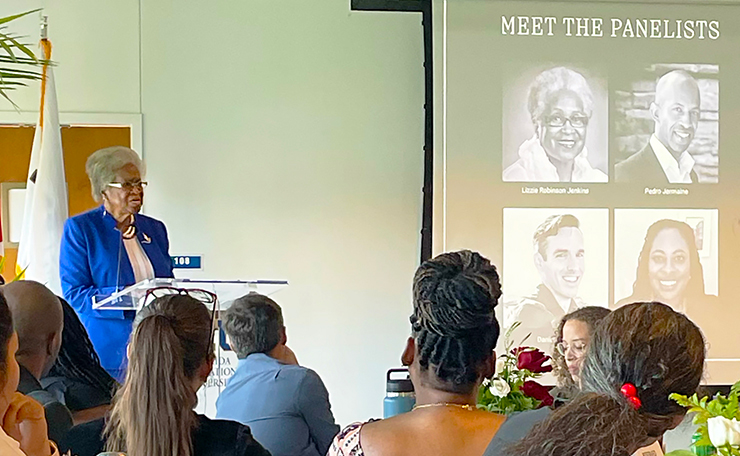
Lizzie Robinson Jenkins speaking at the opening reception. (Photo by Irene Sperber)
Homes were burned to the ground along with businesses and churches. Survivors fled from the small town of about 200 residents.
There are many facets to think through in this exhibition; thorny problems for generations to leap over…while the currents of society run deep through the veins of our ongoing interlocking lives.
I attended the opening reception and panel discussion with Lizzie Robinson Jenkins, Founder of The Real Rosewood Foundation, Inc., following her mother's plea to never allow the story to sink into the swampy history of the Black diaspora of Florida’s past.
The panel was moderated by Alexandria Cornelius Ph.D, director of the Center for Women and Gender Studies in FIU’s Department of History. Daniel Royles, Ph.D, FIU associate professor of history was on hand to dissect the past, along with Pedro Jermaine, Vice President and Resident Artist of The Real Rosewood Foundation. Amy Galpin, curator of the Frost Art Museum, moderated from the art perspective as the Foundation worked in tandem to bring the story alive.
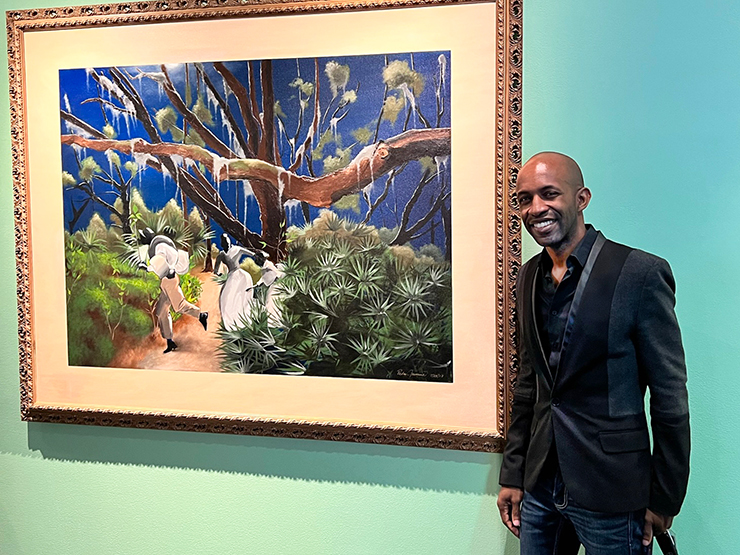
Pedro Jermaine, vice president of Real Rosewood Foundation and Resident Artist, with his work "Hope Prevails." (Photo courtesy of The Frost Art Museum)
Royles pointed out that “this is not a unique event in American history.”
Royles enumerated other full-scale events mirroring the strangely little-known Tulsa Massacre merely two years prior to Rosewood in 1921, when Tulsa’s “Black Wall Street” suffered 35 city blocks of “charred ruins, more than 800 people were treated for injuries and contemporary reports of deaths began at 36. Historians now believe as many as 300 people may have died," according to the Tulsa Historical Society and Museum. The event closely resembled the Rosewood circumstances.
Royles enumerated other Florida incidences: Newbury (hog-stealing lynchings), Ocoee (attempted Black voting), and Perry (murder of a white woman), occurring within the same timeline. More often than not the accusations were of sexual assault, whole swathes of towns were burned and people murdered.
Royles explained the underlying theme of the time: “The thing that precipitated events like Rosewood was not that white women were being threatened by Black predators, it’s that the institutions of white supremacy were being threatened by Black people and Black communities that were standing in their power.” The accusation of sexual assault by a white woman against a Black man escalated into full-scale assaults on entire Black communities. People were told why the violence was 'necessary.' "
It’s important to note here that, unlike similar situations, Rosewood survivors were paid reparations (in 1993) due to “the role historians played in getting some measure of justice.” Royles went on to explain. ”I think these attempts to shut down any discussion of difficult parts of our history, is trying to avoid the issue of reparations…it’s trying to score political points”… “in a larger sense, recognizing that studying history like Rosewood makes it clear to us that way things are now is not the way things have to be.”
“The parts of this country that are almost entirely white are not that way because people just like to be with their own kind…people were driven out of places like Rosewood," Royles said.
"(Others) looked at places like Rosewood, saw what happened and thought it just wasn’t safe to be around white people.” Royles underscored that “violence kept the suburbs white - not because Blacks didn’t want to be there.”
“The true study of history, not the glorification of some mythic past, made this threatening to people trying to maintain the status quo.” “..it means seeing paths that were not taken, the opportunities that were foreclosed, and being able to imagine a better present than the one we are living in. If we can imagine a better present then we can build a more just future. And that is what it means to remember Rosewood in 2023,” Royles concluded.
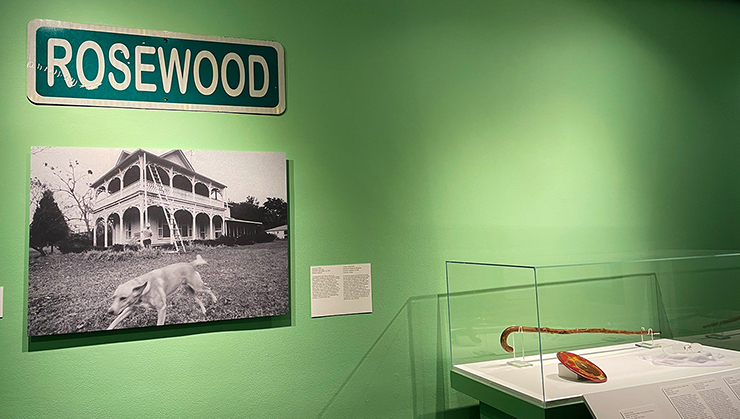
Photo of the John Wright House and Rosewood sign. (Photo of exhibition by Irene Sperber)
Pedro Jermaine was introduced as the Vice President and Resident Artist of the Foundation, amusing the audience by adding “chauffeur” for Lizzie Robinson Jenkins…quipping that it was surreal, like he had a piece of Florida history in his car.
Jermaine and Jenkins discussed his work depicting the residents fleeing into the woods, sometimes hiding for days. Jermaine’s successful “Hope Prevails,” included in this exhibition, is a powerful representation of events. He was highly encouraged by Jenkins to take over as VP for the Foundation. Jermaine gathered artists for this show, aiding in communicating the emotional element. The torn bible on exhibit is the book Jenkins's grandfather used to teach the children to read.
I had a question…
How did you select the artists for this exhibition to fully aide in supporting the project?
Pedro Jermaine: “As the Resident artist, I am tasked with recreating a visual representation symbolizing and commemorating the history of Rosewood. The Real Rosewood Foundation worked in conjunction with the Frost Art Museum in selecting a group of artists, specifically Black female artists, whose works and visions aligned with that of the foundation. It demonstrates the strength ofBblack female artists in the art world which often goes unrecognized.”
The Rosewood Historic marker sponsored/placed by: The Real Rosewood Foundation, Inc. and the Florida Department of State "has been the most desecrated sign in Florida”…18 times, according to Lizzie Jenkins. “History is not political, it’s who we are,” said the formidable and charming Jenkins.
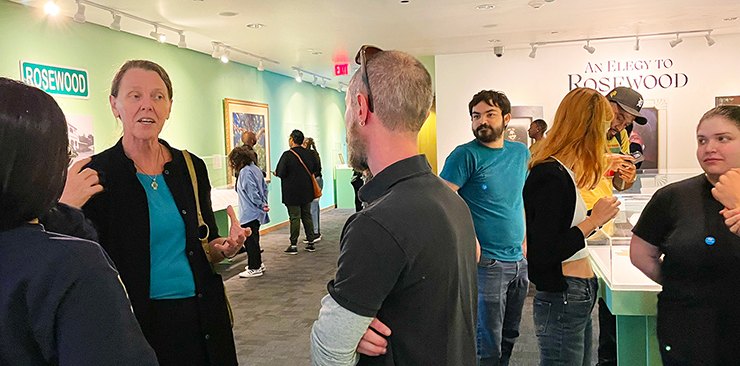
Opening reception of "An Elegy to Rosewood" (Photo by Irene Sperber)
A museum is planned to commemorate and educate on the subject of Rosewood. The Foundation is trying to buy the only remaining house in Rosewood, the John Wright house, and make it an historical landmark.
These presentations are an opportunity to see more clearly why we are, where we are, and to continue researching and learning. If we don’t understand our history, it’s like walking into a movie halfway through…difficult to understand the storyline without background information. Use this exhibition as a jumping off point, gather your own thoughts, connect a few dots.
"Elegy to Rosewood" is part of the Martin Luther King, Jr., Exhibition Series, Four new exhibitions are available for viewing at Patricia and Phillip Frost Museum at FIU.An Elegy to Rosewood, through April 16, 2023 Together/Apart: Modern and Contemporary Art of the United States, through Feb. 2, 2025 Chitra Ganesh: Dreaming in the Multiverse, through April 16, 2023 Everything, Earth and Sky: An Exhibition of Haitian Art, through May 28, 2023)
Frost Art Museum FIU, Modesto Maidique Campus
10975 SW 17 Street, Miami, FL 33199
Info at: (305) 348-2890Curator Tour
Tuesday, Feb. 21, 2023 from noon to 1 p.m. at the museum.
For more information about the project: www.rosewoodflorida.com
For information about the exhibition at Frost, go to frost.fiu.edu




